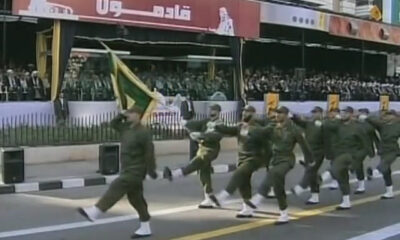Civilization
Air Defense Shapes Warfighting in Ukraine
A team at RAND discusses the increasing role of air defense in the Russia-Ukraine war and how Ukraine has sharpened its air defenses.

Last month over territory controlled by Russia, three of its military aircraft were shot down or damaged. Ukraine’s ground-based air defenses showed their long reach. In another surprise, they have denied overall air superiority to Russia. An air defense revolution may be shaping how Ukraine and perhaps even NATO fight.
Since the Cold War, air defenses have ridden revolutions in microelectronics and computing. Radars detect aircraft at longer ranges. Surface-to-air missiles fly farther. High-value aircraft – such as airborne warning and control, and aerial refueling – retreat to safe distances. Modern aircraft need electronic warfare support to penetrate defended air space. Ukraine’s stealthy cruise missiles paired with radar-jamming MALD missiles have blinded Russian air defenses, but they are few in numbers.
Prior to the full-scale invasion of Ukraine in February 2022, some observers foresaw that Russia’s air force would reign. Its best aircraft see and shoot farther than Ukraine’s and have countermeasures. It was not to be. Even Ukraine’s Soviet-era air defenses, including long-range S-300s, frighten off Russian aircraft. U.S.-supplied Patriots reach deep into Russian-controlled airspace, recently downing expensive A-50 early warning and battle management aircraft.
In Ukraine’s air war, neither side can overfly the other with impunity. Russian helicopter gunships provide some close air support to ground forces, but not enough to turn the tide. As a result, both sides are turning more to artillery and kamikaze drones to support ground operations. Offensive operations are undercut by the absence of air superiority.
Air defense has pushed manned combat aircraft to standoff distances that reduce their effectiveness and lethality. Partially as a result, ground fights may contest only hundreds of meters of territory. Engagement distances of maneuver forces can be below maximum ranges of their weapons systems. Some tank-on-tank skirmishes occur within a stone’s throw of one another.
Protected by an air defense shield, Russian forces in occupied territories have constructed the “most extensive” system of tank ditches, minefields, and other defensive works in Europe since World War II. Lacking close air support, Ukraine’s counter-offensive struggled to breach fortifications. Without it, the kind of sweeping gains Ukrainian ground forces sometimes made in the first year of fighting might be less likely.
Last winter large-scale Russian missile and drone strikes damaged over half of Ukraine’s power infrastructure, leaving many civilians without heat, water, or electricity. Now, Ukrainian forces down most Russian missiles and drones. But enough get through to wreak localized but severe hardships. While U.S.-origin Patriots are destroying some Kinzhal hypersonic missiles, some others might be hard to destroy.
High-end air defense interceptors, such as the Patriot at $4 million a copy, can cost more than the civilian targets they protect or the missiles that threaten them. Layered defenses are more cost-effective. They rely on mixes of more and less expensive air defenses, and of defenses with varying strengths. In the future, innovative guns and directed energy weapons might offer lower costs per shot and higher probabilities of kill for short-range defense. Use of sophisticated Stinger interceptors to take down cheap drones is wasteful.
The Ukraine war might shine a brighter light on challenges facing NATO warfighting and modernization. NATO has counted on local air superiority as a precursor to ground operations. But capable Russian air defenses threaten non-stealth aircraft such as the F-16, Rafale, or Typhoon, designed in the 1970s and 1980s but upgraded since. They may be unable to penetrate defended airspace without assuming significant risk, as seen in some of Ukraine’s air operations.
In the future, low observable combat aircraft, such as F-35s, paired with electronic warfare may be essential to gain air superiority over territory controlled by a capable adversary. The war in Ukraine could spur NATO allies to invest even more in uncrewed and penetrative technologies.
Much of Ukraine’s critical civilian infrastructure, such as energy generation and distribution, is vulnerable to air attack. The same might be true in NATO member states. If Ukraine is a guide, in a conflict NATO air defenses may down most drones and missiles, but some will get through. Ukraine and NATO might reduce risks with a two-prong strategy of strengthening air defenses and boosting infrastructure resilience. Dispersal, hardening, and redundancy are among the ways the latter can be done.
In Ukraine, the strength of air and missile defense has abetted the stalemate in the ground war, but its weakness has led to immense human suffering and infrastructure damage. As the war continues, air defense could become even more salient.
This article was originally published by RealClearDefense and made available via RealClearWire.
-

 Executive4 days ago
Executive4 days agoSecret Service chief gets no solace
-

 Executive3 days ago
Executive3 days agoWaste of the Day: Louisville Taxpayers Pay Nearly $600,000 For Empty Building’s Maintenance, Security
-

 Guest Columns4 days ago
Guest Columns4 days agoFear Itself: Democrats’ Favorite Strategy Caused Their Current Chaos
-

 Executive3 days ago
Executive3 days agoWhere is Joe Biden – or Jill?
-

 Executive1 day ago
Executive1 day agoWaste of the Day: Throwback Thursday: Cities Used Crime Prevention Funds on Soccer Games, Paper Shredding
-

 Executive2 days ago
Executive2 days agoFacile and politically motivated suggestions
-

 Civilization4 days ago
Civilization4 days agoBuild Iron Dome in the United States To Prepare for Israel’s Worst Day
-

 Executive4 days ago
Executive4 days agoThe Emerging GOP Plan To Beat Kamala Harris












